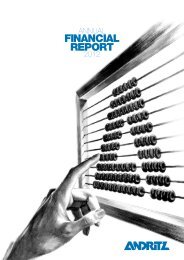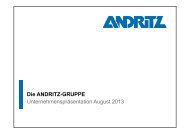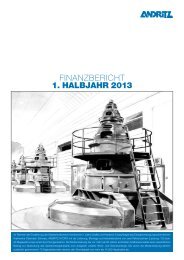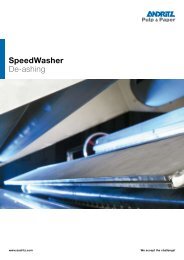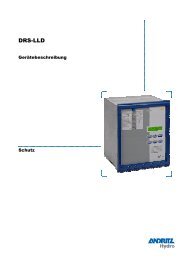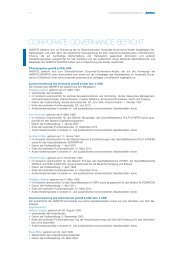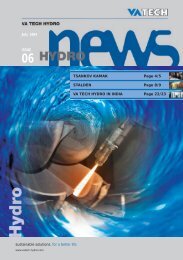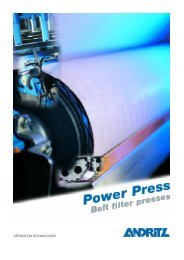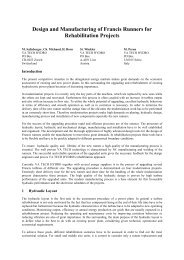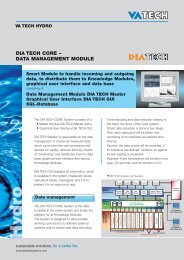FiberSpectrum - ANDRITZ Vertical volute pumps
FiberSpectrum - ANDRITZ Vertical volute pumps
FiberSpectrum - ANDRITZ Vertical volute pumps
Create successful ePaper yourself
Turn your PDF publications into a flip-book with our unique Google optimized e-Paper software.
Veracel Celulose S.A.<br />
Tuning up for higher profits<br />
Even modern and well-managed mills can benefit from a little tuning and optimization.<br />
Combining a new software tool called OPP with knowledge of the mill processes, the<br />
instrumentation and control experts from Sindus Andritz are helping Veracel push more<br />
production through the bleaching line without making any changes to the process<br />
equipment. The payback is measured in days, not years.<br />
▲ Ronaldo Aguilar, Fiberline Coordinator at Veracel. “We asked for production stabilization in the bleach<br />
plant and we got it with OPP. I’m very satisfied with the results so far.”<br />
Ronaldo Aguilar is, admittedly, not an<br />
expert in control theory. His expertise<br />
is in pulp production and leading a<br />
world-class production team.<br />
So Aguilar, Fiberline Coordinator at<br />
Veracel Celulose’s 900,000+ t/a pulp<br />
mill in Brazil, has little interest in the<br />
inner workings of the Optimization of<br />
Process Performance (OPP) software.<br />
He is, however, very interested in<br />
the results that OPP achieved for his<br />
bleaching line – in just one week.<br />
“I don’t need to know how it works, I just<br />
need to know that it does work!” exclaims<br />
Aguilar. “We’re getting a two to<br />
three percent increase in our OEE now.”<br />
20<br />
OEE, Aguilar explains, stands for Overall<br />
Equipment Efficiency, which impacts<br />
the quality, performance, and cost of<br />
production.<br />
A 2-3% production increase in OEE<br />
may not seem like much until you<br />
consider the production capacity of<br />
the Veracel mill. On its best day, the<br />
mill produced a record of nearly 3800<br />
admt/d. The OPP service helped Veracel<br />
establish a new quality record in<br />
October, producing 99.94% prime pulp.<br />
The economics of OPP, according to<br />
Aguilar, are quite favorable.<br />
“We are optimizing each area in terms<br />
of reducing costs and stabilizing<br />
| <strong>FiberSpectrum</strong> 16 – 02/2007<br />
production,” Aguilar says. With all the<br />
production systems at Veracel operating<br />
near full capacity to keep up with<br />
market demand, the bleaching line<br />
was chosen as the first target for OPP<br />
because it is currently the “bottleneck”<br />
(if running above design capacity can<br />
be called a bottleneck).<br />
OPP Service<br />
OPP is a new service offered by Sindus<br />
Andritz (see side story on page 23) to<br />
its pulp and paper clients in Brazil.<br />
Sindus Andritz maintains all the instrumentation<br />
and control systems at Veracel<br />
and 11 other Brazilian mills. Five<br />
mills have OPP systems installed.<br />
Daniel Schuck, Automation Consultant<br />
for Sindus Andritz, is one of the main<br />
developers of OPP and is the product<br />
champion within the company. It took<br />
about two years of internal development<br />
before the service was ready for<br />
use, Schuck says.<br />
“OPP is a combination of special<br />
software and our in-house knowledge<br />
about instrumentation and control systems,<br />
plus our knowledge of our client’s<br />
process,” Schuck says. “Our OPP<br />
service reduces process variability by<br />
analyzing control loops and strategies.<br />
Production is stabilized, costs are reduced,<br />
and maintenance is improved.”<br />
OPP software collects information from<br />
distributed control systems and programmable<br />
logic controllers about each<br />
control loop in the process. It uses a<br />
standard language for automation data<br />
interchange (OLE for Process Control).<br />
“A modern mill has thousands of control<br />
loops,” Schuck says. “We included<br />
sophisticated statistical tools into OPP<br />
that give us an overview of all the loops<br />
that are not performing well. On its<br />
own, the OPP software would be of<br />
little value to our clients. It’s when we<br />
combine it with our knowledge of the<br />
process that we achieve results.”<br />
What does it do?<br />
To understand what OPP does, it first<br />
helps to know a little bit about controllers,<br />
loops, and tuning. Fortunately,<br />
Schuck can explain these terms in such<br />
a way that is understandable to nontechnical<br />
listeners.<br />
“A control loop,” Schuck explains, “consists<br />
of the process, a measurement,<br />
a controller, and an actuator (valve or<br />
other device). The sensor measures<br />
a process variable (like temperature,<br />
pressure, level, or flow) and sends this<br />
measurement to the controller.<br />
“The controller is designed to eliminate<br />
the need for continuous operator attention.<br />
The thermostat in your house is a<br />
common example. You set a comfortable<br />
temperature (the setpoint) and the<br />
thermostat automatically controls the<br />
heating system to hold the temperature<br />
at the desired level.”<br />
Very different controller behaviors can<br />
be considered “good” depending upon<br />
the process. “One process may be<br />
best operated with a fast and aggressive<br />
control action,” Schuck says,<br />
“while another may be better suited for<br />
a slow and gentle response.”<br />
In your home, it would not be a lifethreatening<br />
event if the thermostat<br />
overshot or undershot the temperature<br />
by a degree or two. But in a mill, there<br />
are many areas where the control must<br />
be very precise for safety, quality, or<br />
environmental reasons. This is where<br />
“tuning” comes in.<br />
Schuck explains, “The control response<br />
of each controller can be programmed<br />
to tell it how far to move the actuator<br />
(gain), how fast (time constant), and<br />
how much delay to allow between actions<br />
(dead time).”<br />
The “traditional” way of tuning loops<br />
is by trial and error. An engineer or<br />
technician enters a new setpoint and<br />
observes the process response to the<br />
change. This requires a skilled intuitive<br />
understanding, and only experienced<br />
people are able to achieve good setpoint<br />
response this way.<br />
OPP software automatically identifies<br />
process gain and dead time and gives<br />
recommended tuning. “Then we have<br />
the potential for getting closer to what<br />
the process is actually capable of,”<br />
Schuck says. “However, we at<br />
Sindus Andritz never take a tuning<br />
▲ Based upon the input from the OPP system, it<br />
was determined that the bad control loop was due<br />
to a faulty valve positioner. Here Nelson Vaverro<br />
of Sindus Andritz performs a test on the instrument<br />
to confirm the problem.<br />
▲ Marcelo Verlings, Automation Technician<br />
for Sindus Andritz working at the Veracel mill,<br />
uses OPP to identify a control loop that is not<br />
performing.<br />
◄ Sindus Andritz is working with Veracel to<br />
optimize the automated control of each process<br />
area. The first target was the bleach plant – where<br />
production was increased by 2-3%.<br />
21





